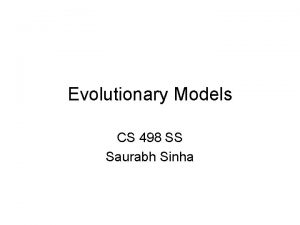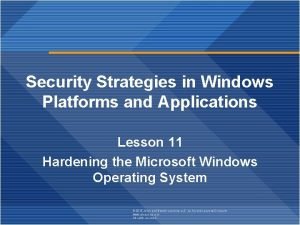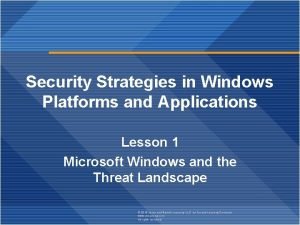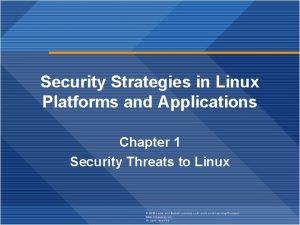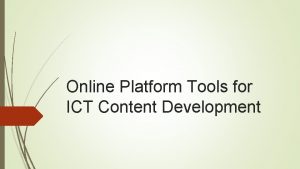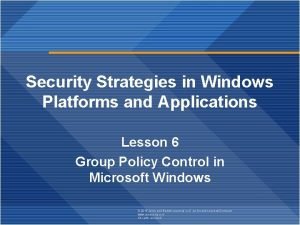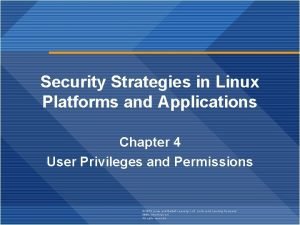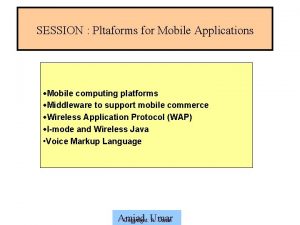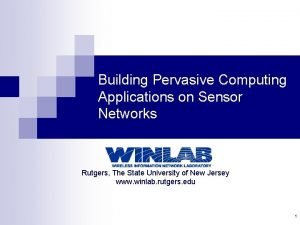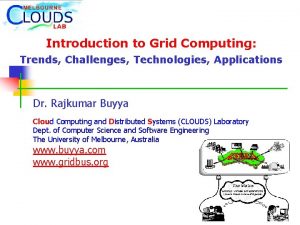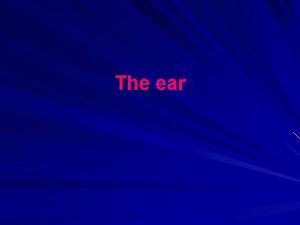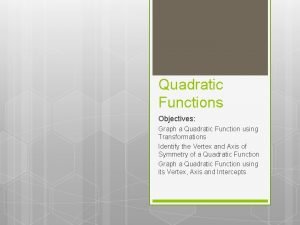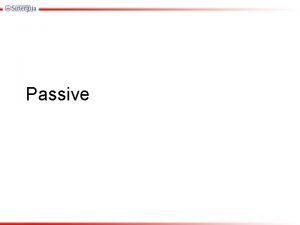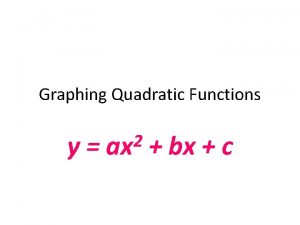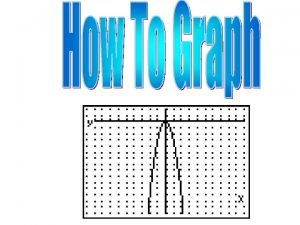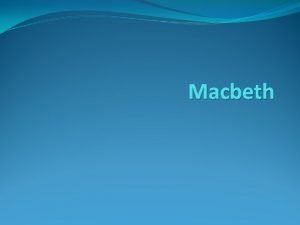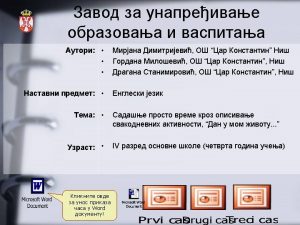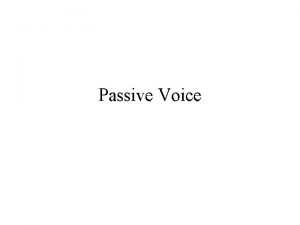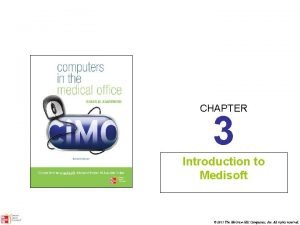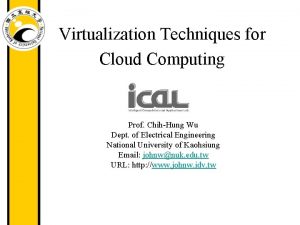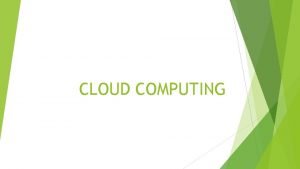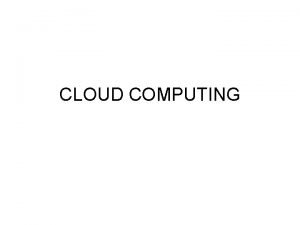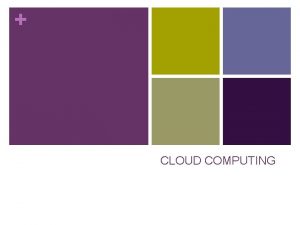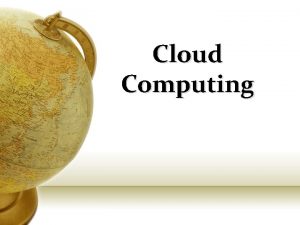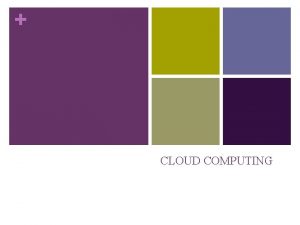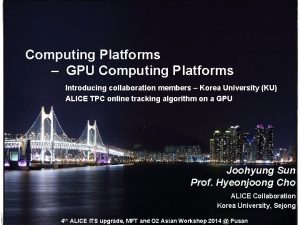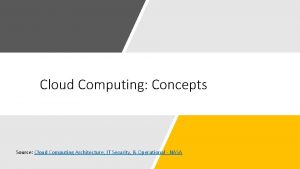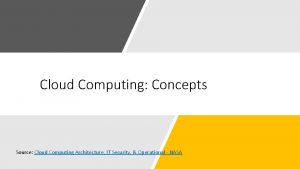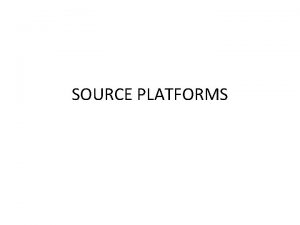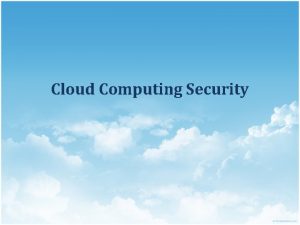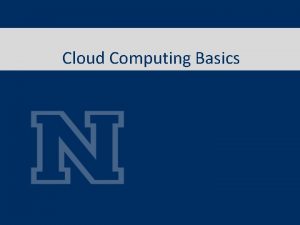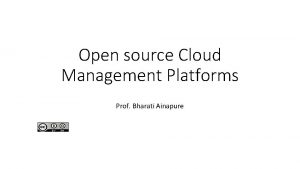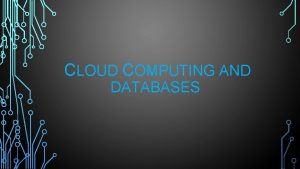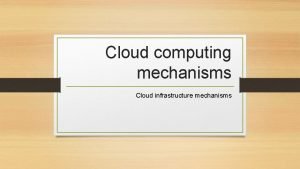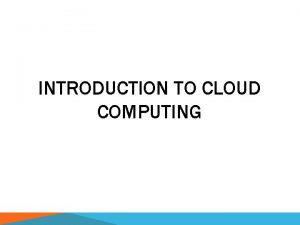Cloud computing Opens source platforms Cloud applications Dan































- Slides: 31

Cloud computing Opens source platforms. Cloud applications Dan C. Marinescu Computer Science Division, EECS Department University of Central Florida Email: dcm@cs. ucf. edu

Contents n n n Energy use and ecological impact of data centers Service Level Agreements Software licensing Basic architecture of cloud platforms Open-source platforms for cloud computing Eucalyptus ¨ Nebula ¨ Nimbus ¨ n Cloud applications ¨ ¨ ¨ 9/19/2021 Challenges Existing and new applications Coordination and the Zookeeper The Map-Reduce programming model The Grep. The. Web application Clouds in science and engineering UTFSM - May-June 2012 2

The ratio of the costs for medium size (with around 1, 000 systems) versus large (with more than 50, 000 systems) data centers. n The costs for the computing and communication infrastructure for medium and large data centers: (a) networking - in dollars per Mbit/sec/month; (b) storage - dollars per GByte/month; and (c) system administrators. 9/19/2021 UTFSM - May-June 2012 3

9/19/2021 UTFSM - May-June 2012 4

AWS – Amazon Web Services 9/19/2021 UTFSM - May-June 2012 5

Energy use; ecological impact of data centers n n A 2010 report shows that a typical Google cluster spends most of its time within the 10 -50% CPU utilization range. The operating efficiency of a system is captured by performance per Watt of power. Imbalance between the rates, for example, during the period 1998 -2007, the performance of supercomputers has increased 7000% while their operating efficiency has increased only 2000%!! In an ideal world, the energy consumed by an idle system should be near zero and should grow linearly with the system load. In real life, even machines whose power requirements scale linearly when idle use more than half the power they use at full load. An energy-proportional system consumes no power when idle, very little power under a light load and, gradually, more power as the load increases. By definition, an ideal energy-proportional system is always operating at 100% efficiency. Humans are a good approximation of an ideal energy proportional system; the human energy consumption is about 70 W at rest, 120 W on average on a daily basis, and can go as high as 1000 2000 W during a strenuous, short time effort. UTFSM - May-June 2012 6

n The typical operating region for the servers at a data center is from about 10% 50% of the load. Even when power requirements scale linearly with the load, the energy efficiency of a computing system is not a linear function of the load; when idle, a system may use 50% of the power corresponding to the full load. 9/19/2021 UTFSM - May-June 2012 7

Present and projected energy consumption n The dynamic range of different components of a computing system The processors used in servers consume less than one-third of their peak power at very-low load and have a dynamic range of more than 70% of peak power; the processors used in mobile and/or embedded applications are better in this respect. The dynamic power range of other components of a system is much narrower: ¨ less than 50% for DRAM, 25% for disk drives. ¨ 15% for networking switches. ¨ n n In 2006, the 6000 data centers in the U. S. reportedly consumed 61 x 109 KWh of energy, 1. 5% of all electricity consumption in the country, at a cost of 4$. 5 billion. The energy consumption of data centers and the network infrastructure is predicted to reach 10, 300 Twh in 2030, based on 2010 levels of efficiency 9/19/2021 UTFSM - May-June 2012 8

Service Level Agreements (SLAs) n An SLA is a negotiated contract between two parties, the customer and the service provider; the agreement can be legally binding or informal and specifies the services that the customer receives, rather than how the service provider delivers the services. Its objective are: ¨ ¨ ¨ n Identify and define the customer’s needs and constraints including the level of resources, security, timing, and quality of service. Provide a framework for understanding; a critical aspect of this framework is a clear definition of classes of service and the costs. Simplify complex issues; clarify the boundaries between the responsibilities of the clients and of the provider of service in case of failures. Reduce areas of conflict. Encourage dialog in the event of disputes. Eliminate unrealistic expectations. Each area of service should define a ``target level of service'' or/and a ``minimum level of service'' and specify the levels of availability, serviceability, performance, operation, and billing; penalties may also be specified in the case of non-compliance with the SLA. 9/19/2021 UTFSM - May-June 2012 9

More on SLAs n An SLA records a common understanding in several areas: 1. 2. 3. 4. 5. n services, priorities, responsibilities, guarantees, and warranties. An agreement usually covers: 1. 2. 3. 4. 5. 6. 7. 8. 9. services to be delivered, performance, tracking and reporting, problem management, legal compliance and resolution of disputes, customer duties and responsibilities, security, handling of confidential information, and termination. 9/19/2021 UTFSM - May-June 2012 10

Software licensing n n n Software licensing for cloud computing is an enduring problem without a universally accepted solution at this time. The license management technology is based on the old model of computing centers with licenses given on the basis of named users or as a site license. Recently IBM has reached an agreement allowing some of its software products to be used on EC 2. Math. Works developed a business model for the use of MATLAB in Grid environments. Saa. S is gaining acceptance as it allows users to pay only for the services they use. elastic. LM is a commercial product which provides license and billing Web-based services. The elastic. LM license service has several layers: coallocation, authentication, administration, management, business, and persistency. The authentication layer authenticates communications between the license service and the billing service and individual applications; the persistence layer stores the usage records; the main responsibility of the business layer is to provide the licensing service with the licenses prices; the management coordinates different components of the automated billing service. 9/19/2021 UTFSM - May-June 2012 11

9/19/2021 UTFSM - May-June 2012 12

What to expect from open-source platform for cloud computing n Schematically, a cloud infrastructure carries out the following steps to run an application: ¨ ¨ ¨ 9/19/2021 retrieves the user input from the front-end; retrieves the disk image of a VM (Virtual Machine) from a repository; locates a system and requests the VMM (Virtual Machine Monitor) running on that system to setup a VM; allows the developer to start an instance invokes the DHCP to get an internal IP address for the instance UTFSM - May-June 2012 13

Eucalyptus (http: //www. eucalyptus. com/) n n Open-source counterpart of Amazon's EC 2. The system can support a large number of users in a corporate enterprise environment. Users are shielded from the complexity of disk configurations and can choose for their VM from a set of 5 configurations for available processors, memory and hard drive space setup by the system administrators. The system supports: strong separation between the user space and administrator space; users access the system via a Web interface while administrators need root access; ¨ decentralized resource management of multiple clusters with multiple cluster controllers, but a single head node for handling user interfaces. ¨ n It implements a distributed storage system, the analog of Amazon’s S 3 system, called Walrus. 9/19/2021 UTFSM - May-June 2012 14

The procedure to construct a virtual machine using Eucalyptus 1. 2. 3. 4. 5. 6. 7. Use the euca 2 ools front-end to request a VM; the information about the tolls is available at http: //open. eucalyptus. com/wiki/Euca 2 ools. Guide_v 1. 3 The VM disk image is transferred to a compute node; This disk image is modified for use by the VMM on the compute node; The compute node sets up network bridging to provide a virtual NIC with a virtual MAC address In the head node the DHCP is set up with the MAC/IP pair; VMM activates the VM; The user can now ssh directly into the VM; ssh uses public-key cryptography to authenticate the remote computer and allow the remote computer to authenticate the user. 9/19/2021 UTFSM - May-June 2012 15

Open-Nebula: http: //www. opennebula. org n n n The system is centralized; by default it uses the NFS file system. Best suited for an operation involving a small to medium size group of trusted and knowledgeable users who are able to configure this versatile system based on their needs. The procedure to construct a virtual machine consists of several steps: 1. 2. 3. 4. 5. 6. 7. 8. a user signs in to the head node using ssh; the user issues the onevm command to request a VM; the VM template disk image is transformed to fit the correct size and configuration within the NFS directory on the head node; the oned daemon on the head node uses ssh to log into a compute node; the compute node sets up network bridging and provides virtual NIC & MAC; the files needed by the VMM are transferred to the compute node via NFS; the VMM on the compute note starts the VM; the user is able to ssh directly to the VM on the compute node. 9/19/2021 UTFSM - May-June 2012 16

Nimbus - http: //www. nimbusproject. org/ n n n Nimbus is a cloud solution for scientific applications based on the Globus software. The system inherits from Globus the image storage, the credentials for user authentication, and the requirement that the running Nimbus process can ssh into all compute nodes. Customization in this system can only be done by the system administrators. 9/19/2021 UTFSM - May-June 2012 17

9/19/2021 UTFSM - May-June 2012 18

Cloud applications n n n The main attraction of cloud computing is the ability to use as many servers as necessary to optimally respond to cost and timing constraints. The arbitrarily divisible load sharing model is common to many applications and these are precisely the applications suitable for cloud computing. Web services, database services, and transaction-based services are ideal applications for cloud computing. Applications where the workload cannot be arbitrarily partitioned, or require intensive communication among concurrent instances are unlikely to perform well on a cloud. The data storage plays a critical role in the performance of any dataintensive application. Clouds support many storage options to set up a file system similar to the Hadoop file system; among them are off-instance cloud storage (e. g. , S 3), mountable off-instance block storage (e. g. , EBS), as well as, storage persistent for the lifetime of the instance. Cloud infrastructures exhibit inter-node latency and bandwidth fluctuations which affect the application performance 9/19/2021 UTFSM - May-June 2012 19

Existing cloud applications n Processing pipelines 1. 2. 3. 4. 5. n Indexing; the processing pipeline supports indexing of large datasets created by Web crawl engines. Data mining; the processing pipeline supports searching very large collections of records to locate items of interests. Image processing; a number of companies allow users to store their images on the cloud, e. g. , flickr. com) and Google (http: //picasa. google. com/). The image processing pipelines support image conversion, e. g. , enlarge an image or create thumbnails; they can also be used to compress or encrypt images. Video transcoding; the processing pipeline transcodes from one video format to another, e. g. , from AVI to MPEG. Document processing; the processing pipeline converts very large collection of documents from one format to another, e. g. , from Word to pdf or encrypt the documents; they could also use OCR (Optical Character Recognition) to produce digital images of documents. Web applications – Several categories of Web sites have a periodic or temporary presence; Web site for conferences, Web sites active during a particular season or supporting a particular type of activity, income tax reporting 9/19/2021 UTFSM - May-June 2012 20

Existing cloud applications (cont’d) n Batch processing systems ¨ ¨ ¨ Generation of daily, weekly, monthly, and annual activity reports for organizations in retail, manufacturing, and other economical sectors. Processing, aggregation, and summaries of daily transactions for financial institutions, insurance companies, and healthcare organizations. Inventory management for large corporations. Processing billing and payroll records. Management of the software development, e. g. , nightly updates of software repositories. Automatic testing and verification of software and hardware systems. 9/19/2021 UTFSM - May-June 2012 21

New classes of applications could emerge n n n Batch processing for decision support systems and other aspects of business analytics. Parallel batch processing based on programming abstractions such as Map. Reduce from Google. Mobile interactive applications which process large volumes of data from different types of sensors. Services that combine more than one data source, e. g. , mashups. Science and engineering could greatly benefit from cloud computing as many applications in these areas are compute-intensive and dataintensive. A cloud dedicated to education would be extremely useful. 9/19/2021 UTFSM - May-June 2012 22

Coordination based on a state machine model n n The Zoo. Keeper (http: //zookeeper. apache. org/) a distributed coordination service based on the Paxos algorithm (discussed next). A set of servers maintain consistency of the database replicated on each one of them. The open-source software is written in Java and has bindings for Java and C. The system guarantees: ¨ ¨ ¨ Atomicity - a transaction either completes of fails; Sequential consistency of updates - updates are applied strictly in the order they are received; Single system image for the clients - a client receives the same response regardless of the server it connects to; Persistence of updates - once applied, an update will persists until it is overwritten by a client. Reliability - the system is guaranteed to function correctly as long as the majority of servers function correctly. 9/19/2021 UTFSM - May-June 2012 23

n (a) The service provides a single system image, clients can connect to any server. (b) Functional model of the service; the replicated database is accessed directly by READ commands, while WRITE commands involve a more intricate processing based on atomic broadcast. (c) Processing a WRITE command - a server receiving the command from a client connected to it forwards the command to the leader; the leader uses atomic broadcast to reach consensus among all other servers which play the role of followers. 9/19/2021 UTFSM - May-June 2012 24

Consensus the Paxos algorithm 9/19/2021 UTFSM - May-June 2012 25

The Map-Reduce programming model n n A programming model inspired by the Map and the Reduce primitives of Lisp; it was conceived for processing and generating large data sets on computing clusters. As a result of the computation, a set of input <key, value> pairs is transformed into a set of output <key, value> pairs. For example, one can process logs of Web page requests and count the URL access frequency; the Map function outputs the pairs <URL, 1> and the Reduce function produces the pairs <URL, totalcount>. Another trivial example is distributed sort when the Map function extracts the key from each record and produces a <key, record> pair and the Reduce function outputs these pairs unchanged. 9/19/2021 UTFSM - May-June 2012 26

Grep. The. Web n n The application allows a user to define a regular expression and search the Web for records that match it; Grep. The. Web is analogous to the grep Unix command used to search a file for a given regular expression. The source of the search is a collection of document URLs produced by the Alexa Web Search, a software system that crawls the Web every night. The inputs to the applications are a regular expression and the large data set produced by the Web crawling software; the output is the set of records that satisfy the expression. The user is able to interact with the application and get the current status. It uses Hadoop Map. Reduce, an open source software package that splits a large data set into chunks, distributes them across multiple systems, launches the processing, and, when the processing is complete, aggregates the outputs from different systems into a final result. 9/19/2021 UTFSM - May-June 2012 27

Grep. The. Web uses the Map. Reduce n n n In the first step, the Map step, the master node takes the input, partitions it into smaller sub-problems, and distributes them to worker nodes; a worker node may repeat the process, leading to a multi-level tree structure. A worker node processes the data allocated to it and passes the answer back to its master node. In the second phase, the Reduce phase, the master node merges the partial results and provides the answer to the problem it was originally trying to solve. Map. Reduce libraries are available for C++, C#, Erlang, Java, OCaml, Perl, Python, PHP, Ruby, and other programming languages. 9/19/2021 UTFSM - May-June 2012 28

The workflow of Grep. The. Web n n Start-up phase: create several queues - launch, monitor, billing, and shutdown queues; start the corresponding controller threads. Each thread polls periodically its input queue and when a message is available, retrieves the message, parses it, and takes the required actions. Processing phase: triggered by a Start. Grep user request; then a launch message is enqueued in the launch queue. The launch controller thread picks up the message and executes the launch task; then, it updates the status and time stamps in the Simple. DB domain. Lastly, it enqueues a message in the monitor queue and deletes the message from the launch queue. The processing phase consists of the following steps: The launch task starts Amazon EC 2 instances using a Java Runtime Environment preinstalled Amazon Machine Image (AMI), deploys required Hadoop libraries and starts a Hadoop Job (run Map/Reduce tasks). ¨ Hadoop runs map tasks on Amazon EC 2 slave nodes in parallel; a map task takes files from Amazon S 3, runs a regular expression and writes locally the match results along with a description of up to five matches; then the combine/reduce task combines and sorts the results and consolidates the output. ¨ The final results are stored on Amazon S 3 in the output bucket. ¨ 9/19/2021 UTFSM - May-June 2012 29

Grep. The. Web application uses three Amazon services: Simple. DB, SE 2, and S 3, and the Hadoop Map. Reduce software. (a) The simplified workflow showing the two inputs, the regular expression and the input records generated by the Web crawler; a third type of input are the user commands to report the current status and to terminate the processing. (b) The detailed workflow; the system is based on message passing between several queues; four controller threads periodically poll their associated input queues, retrieve messages, and carry out the required actions 9/19/2021 UTFSM - May-June 2012 30

Next seminar: Thursday, June 7, 2012 n n n Layering and virtualization Virtual mahines Virtual machine monitors Performance isolation; security isolation Full and paravirtualization Xen 9/19/2021 UTFSM - May-June 2012 31
 Cs 498 cloud computing applications
Cs 498 cloud computing applications Security strategies in windows platforms and applications
Security strategies in windows platforms and applications Security strategies in windows platforms and applications
Security strategies in windows platforms and applications Security strategies in linux platforms and applications
Security strategies in linux platforms and applications Ict content creation
Ict content creation Security strategies in windows platforms and applications
Security strategies in windows platforms and applications Www.jblearning.com login
Www.jblearning.com login Mobile computing platforms
Mobile computing platforms Seven step model of migration into cloud
Seven step model of migration into cloud Computing applications building
Computing applications building Challenges of grid computing
Challenges of grid computing Csi-321 introduction to computing applications
Csi-321 introduction to computing applications Conventional computing and intelligent computing
Conventional computing and intelligent computing Every time jarrad opens his cigarette case
Every time jarrad opens his cigarette case If god closes a door he opens a window
If god closes a door he opens a window Oval window opens into
Oval window opens into How to graph quadratic functions in excel
How to graph quadratic functions in excel Someone made this antique table in 1734
Someone made this antique table in 1734 He opens the door.
He opens the door. Minimum and maximum of a quadratic function
Minimum and maximum of a quadratic function Standard form quadratic equation
Standard form quadratic equation Chapter 11 percy jackson lightning thief
Chapter 11 percy jackson lightning thief The play opens with
The play opens with Macbeth summary
Macbeth summary Backstage view opens when you click the
Backstage view opens when you click the I usually get up half past eight
I usually get up half past eight Rewrite the sentences in passive voice he opens the door
Rewrite the sentences in passive voice he opens the door Dee trader opens a brokerage account
Dee trader opens a brokerage account How many major types of data are stored in medisoft
How many major types of data are stored in medisoft Vodafone hosting on cloud
Vodafone hosting on cloud Full virtualization in cloud computing
Full virtualization in cloud computing Virtualization structure in cloud computing
Virtualization structure in cloud computing
